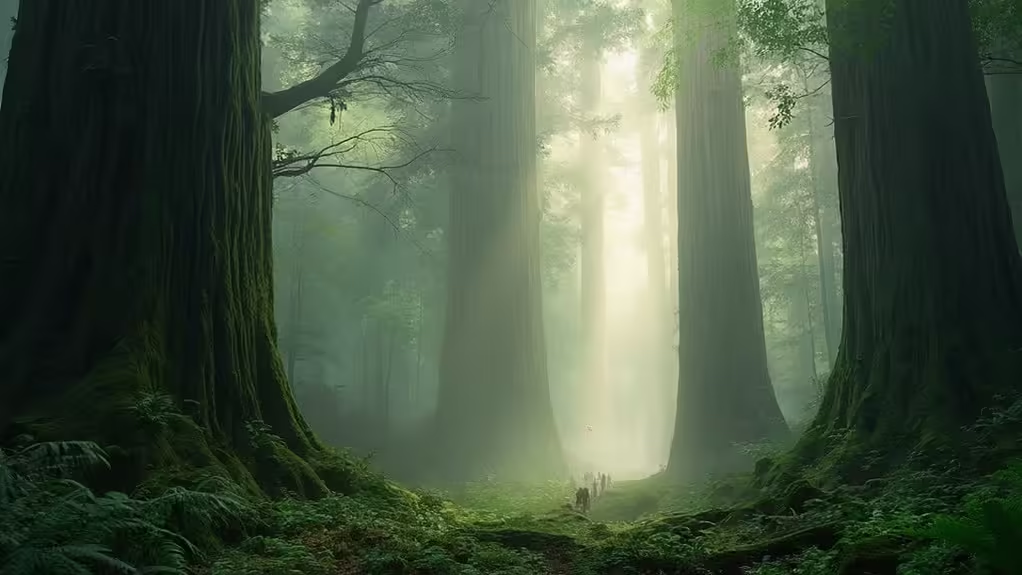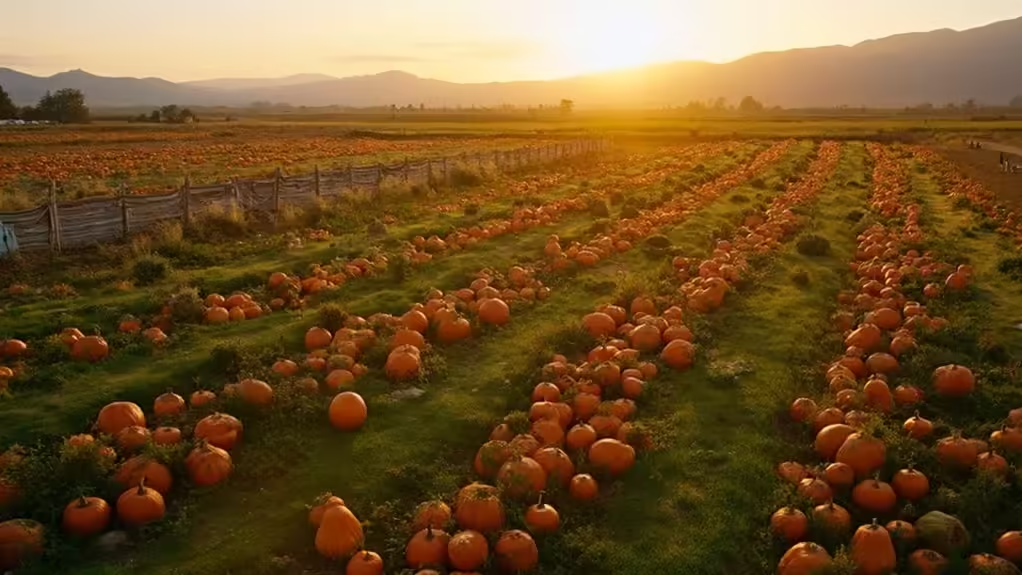You'll find the world's tallest trees, coastal redwoods, towering over 370 feet in the misty forests of Northern California. These ancient giants, some over 2,500 years old, have specialized adaptations that allow them to thrive. The tallest known redwood, Hyperion, stands at an impressive 380.81 feet in Redwood National Park. These trees create a unique ecosystem in their canopy, supporting over 1,000 species. Conservation efforts are essential to protect these natural wonders from threats like wildfires and human impact. When you visit, you'll be awestruck by their majesty and learn about their cultural significance. There's so much more to uncover about these extraordinary living skyscrapers.
Table of Contents
ToggleLearn More
- Hyperion, discovered in 2006, is the world's tallest known living tree at 380.81 feet (116.07 meters) tall.
- Helios and Stratosphere Giant are recognized as the second and fourth tallest redwoods, respectively.
- Redwood National Park in Northern California is home to these ancient giants, some over 2,500 years old.
- The exact locations of the tallest trees are kept secret to protect them from potential damage.
- Redwoods can reach heights over 370 feet, with specialized adaptations like fog water collection aiding their growth.
Discovering Redwood Giants
Step into the world of redwood giants, where towering trees reach for the sky and leave visitors in awe. You'll find these ancient wonders in the coastal forests of Northern California, where fog rolls in and nourishes the old growth redwoods. These aren't just any trees; they're living skyscrapers that have stood for thousands of years.
In 2006, scientists made an incredible revelation in Redwood National Park. They found Hyperion, the tallest known living tree on Earth, stretching an astonishing 379.1 feet into the air. It's not alone in its majesty, though. Just a stone's throw away, you'll find Helios, the second tallest redwood, standing proud at 377 feet. These giants aren't confined to one area. If you venture to Humboldt Redwoods State Park, you can marvel at the Stratosphere Giant, the fourth tallest tree at 371.1 feet.
These redwoods aren't just tall; they're ancient. Some have been alive for over 2,500 years, witnessing centuries of history. As you walk among these giants, you're stepping into a living museum of time and nature's grandeur.
Hyperion: King of the Canopy
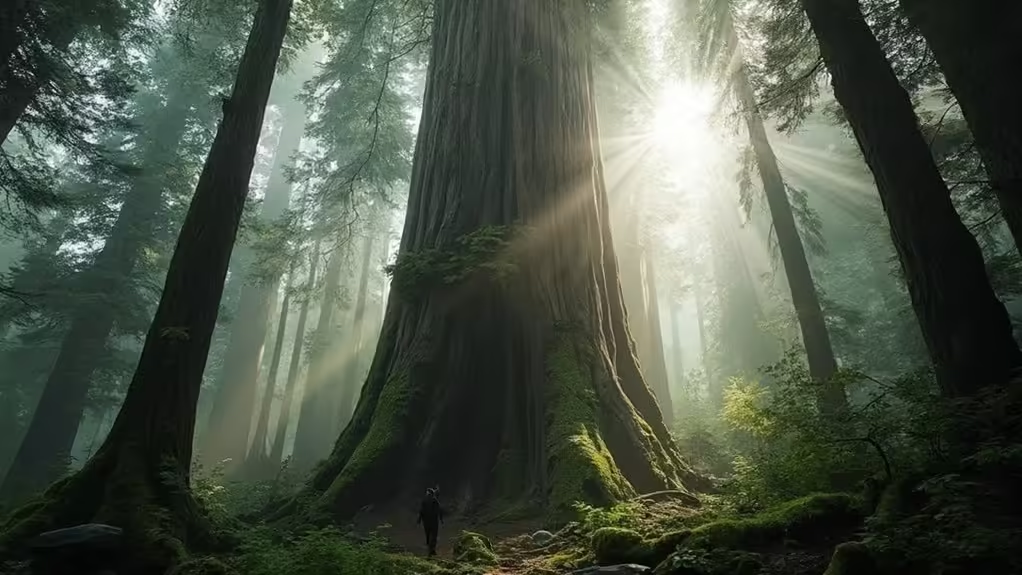
Towering above all others, Hyperion reigns supreme as the tallest known living tree on Earth. You'll find this majestic giant in California's Redwood National Park, stretching an incredible 380.81 feet (116.07 meters) into the sky. Uncovered in 2006 by researchers Chris K. Atkins and Michael W. Taylor, Hyperion is estimated to be 600 to 800 years old, a true indication of the longevity of redwood tree species.
To protect this natural wonder from potential damage, its exact location remains a secret. The surrounding forest area is closed to the public, preserving the delicate ecosystem that supports Hyperion and its fellow redwoods. Here's a quick overview of Hyperion's impressive statistics:
| Feature | Measurement | Unit |
|---|---|---|
| Height | 380.81 | feet |
| Diameter | 15.20 | feet |
| Volume | 18,783 | cubic feet |
| Age | 600-800 | years |
As you imagine Hyperion's towering presence, remember that it's not just a record-holder but a living piece of history. Its massive trunk and soaring canopy serve as a reminder of nature's awe-inspiring power and the importance of conservation efforts to protect these incredible trees for future generations to admire and study.
Remarkable Growth and Adaptations
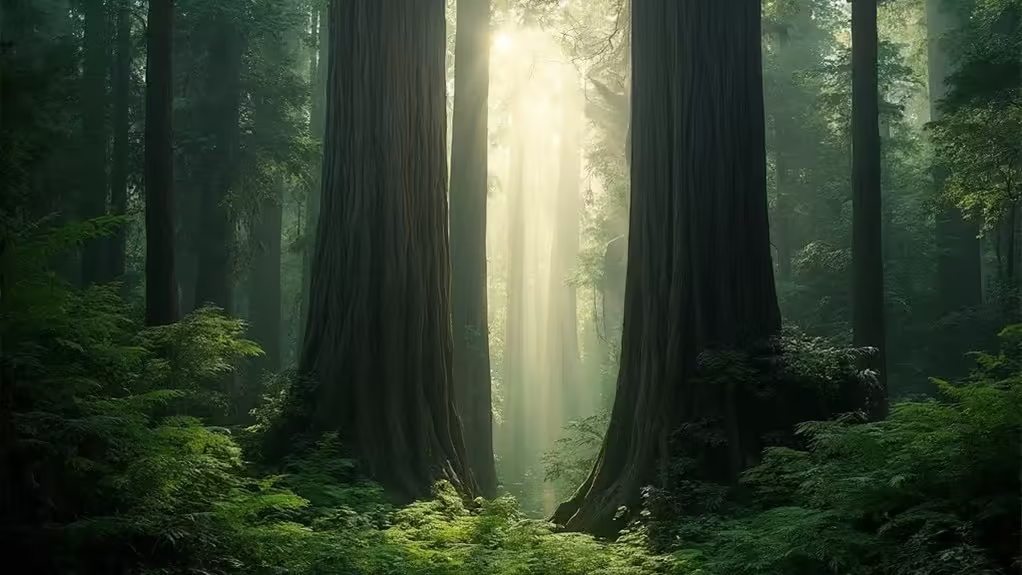
You'll be amazed by the redwood's incredible adaptations for growth and survival. These giants have specialized leaf structures that can capture moisture from fog, allowing them to thrive in coastal environments. Their root systems, though shallow, spread wide to stabilize the massive trees and efficiently absorb water from the often-saturated forest floor.
Fog-Harvesting Leaf Structures
Marvels of adaptation, redwood trees have developed specialized leaf structures that allow them to thrive in coastal environments by collecting moisture from fog. You'll be astounded at how these giants quench their thirst without relying solely on their roots. Coast redwoods have flat, needle-like leaves that maximize surface area, giving them the freedom to capture water droplets from the air. This clever design helps them minimize water loss through evaporation, too.
Imagine standing beneath these towering trees, feeling the cool mist on your skin. That same fog is providing up to 30% of the redwoods' annual water needs, especially during dry summer months. It's like they've found a secret source of hydration that keeps them growing tall and strong. The trees even have a special trick called "foliar uptake," where they can drink water directly through their leaves from fog and rain. This incredible ability to collect moisture from the air contributes to their extraordinary growth rates and helps them reach staggering heights. You're witnessing nature's ingenuity at its finest, as these majestic redwoods utilize the power of fog to flourish.
Adaptive Root Systems
Beneath the towering giants lies an equally impressive network of roots that sets redwoods apart. These California natives, including coast redwoods and giant sequoias, have developed an adaptive root system that's as extraordinary as their height. You'll be amazed to learn that despite their massive size, redwood trees have surprisingly shallow roots. However, what they lack in depth, they make up for in spread and interconnectedness.
The root system of redwoods is a marvel of nature, offering:
- Extensive reach, spreading up to 150 feet from the tree's base
- Intertwining roots that create a supportive network among neighboring trees
- Efficient moisture absorption from fog and rainfall
- Exceptional regeneration abilities after disturbances
This unique root structure provides stability and moisture to these towering giants, allowing them to thrive in diverse soil types. It's a demonstration of nature's ingenuity, enabling redwoods to stand tall against strong winds and erosion. You'll appreciate how these trees have adapted to their environment, using their roots to tap into water sources and create a sturdy foundation. It's this incredible adaptability that has allowed redwoods to survive and flourish for millennia.
Ecosystem Within the Treetops

Soaring hundreds of feet above the forest floor, the canopy of coast redwood trees harbors a lively ecosystem teeming with life. You'll find a world of biodiversity up there, with over 1,000 species calling these treetops home. It's a hidden domain where birds, insects, and plants thrive in a unique, fog-nourished environment.
The redwood canopy isn't just a place to live; it's a complex food web. Organic material accumulates, providing nutrients for the diverse inhabitants. Fallen leaves and branches create a rich habitat that supports an intricate network of life. You'll even find "nurse logs" up there, where fallen redwood trunks nurture younger plants and fungi.
Here's a glimpse into the redwood canopy ecosystem:
| Canopy Feature | Function | Examples |
|---|---|---|
| Fog moisture | Sustains life | Ferns, mosses |
| Organic matter | Provides nutrients | Detritus, fallen leaves |
| Tree structure | Creates habitats | Epiphytic plants, insects |
| Nurse logs | Cultivates new growth | Young plants, fungi |
This high-altitude world is a reflection of nature's ingenuity. It's a reminder that life finds a way, even in the most unexpected places. The redwood canopy shows us that freedom and adaptability go hand in hand in the natural world.
Conservation Challenges and Efforts

When you visit redwood forests, you'll encounter protective measures designed to manage visitor impact and preserve these magnificent trees. Park regulations, like those protecting the Hyperion tree, help maintain the delicate ecosystems that redwoods call home. As wildfires increasingly threaten these ancient giants, conservationists are working tirelessly to develop and implement effective fire management strategies to safeguard these irreplaceable natural wonders.
Visitor Impact Management
The delicate balance between conservation and tourism poses significant challenges for redwood forests. You might be eager to see the world's tallest trees, but visitor access to giants like Hyperion is restricted to protect their fragile ecosystems. With many visitors flocking to these majestic areas, the need for responsible stewardship is more critical than ever, as highlighted by the importance of California's most underrated state parks. The National Park Service is working hard to promote responsible tourism and educate visitors about the ecological significance of these ancient wonders. Additionally, efforts to maintain the balance between conservation and tourism include promoting alternative attractions and activities within the redwood forests, such as stunning coastal hikes. By diversifying the visitor experience, the pressure on the old-growth forests can be alleviated, allowing for more sustainable tourism practices. Educating visitors about the value of these stunning coastal hikes can also help spread awareness about the need to preserve and protect these natural wonders for future generations to enjoy. In addition to the efforts of the National Park Service, California state parks also play a crucial role in the preservation of redwood forests. Through a combination of strict regulations and ongoing conservation initiatives, these parks strive to balance the desire for public access with the need to protect the delicate ecosystems within their boundaries. By raising awareness about the importance of responsible tourism and offering educational programs, California state parks are working alongside the National Park Service to ensure that these majestic redwood forests can be enjoyed by future generations.
As you investigate redwood forests, remember that your actions can have a big impact. Here's what you need to know:
- Straying from marked trails can damage shallow root systems
- Bushwhacking creates unwanted side trails, disrupting the forest floor
- Wildfires pose a serious threat to giant sequoias
- Violating access restrictions can result in hefty fines or even jail time
Conservation challenges are mounting, with recent fires decimating a significant portion of the world's giant sequoia population. It's up to you to help protect these magnificent trees. Stick to designated paths, follow park regulations, and learn about the unique ecosystem you're visiting. By being a responsible tourist, you're not just preserving the redwoods for future generations – you're also ensuring your own freedom to enjoy these natural wonders for years to come.
Wildfire Mitigation Strategies
Flames licking at ancient bark have become an all-too-common sight in California's redwood forests. You've probably heard about the devastating wildfires that have ravaged these majestic giants, with a staggering 10-14% of the world's giant sequoias lost in 2021 alone. But don't lose hope! Conservation efforts are in full swing to protect these incredible trees. In fact, organizations like the Save the Redwoods League and the National Park Service are working tirelessly to mitigate fire risks and ensure the long-term survival of these ancient giants. Additionally, visitors can support the cause by being mindful of fire safety and following guidelines when exploring California fall foliage spots that are home to these remarkable redwoods. With continued commitment and proactive measures, we can help preserve these natural wonders for future generations to enjoy.
The National Park Service is leading the charge with smart fire management strategies. They're using controlled burns to clear out undergrowth and create defensible space around these towering titans. It's like giving the redwoods a fighting chance against future infernos.
You can be part of the solution too! Get involved with local environmental groups to spread awareness about wildfire mitigation in redwood ecosystems. These organizations are working hard to establish firebreaks and thin out dense forest areas, reducing the risk of catastrophic fires.
Visiting Redwood National Park
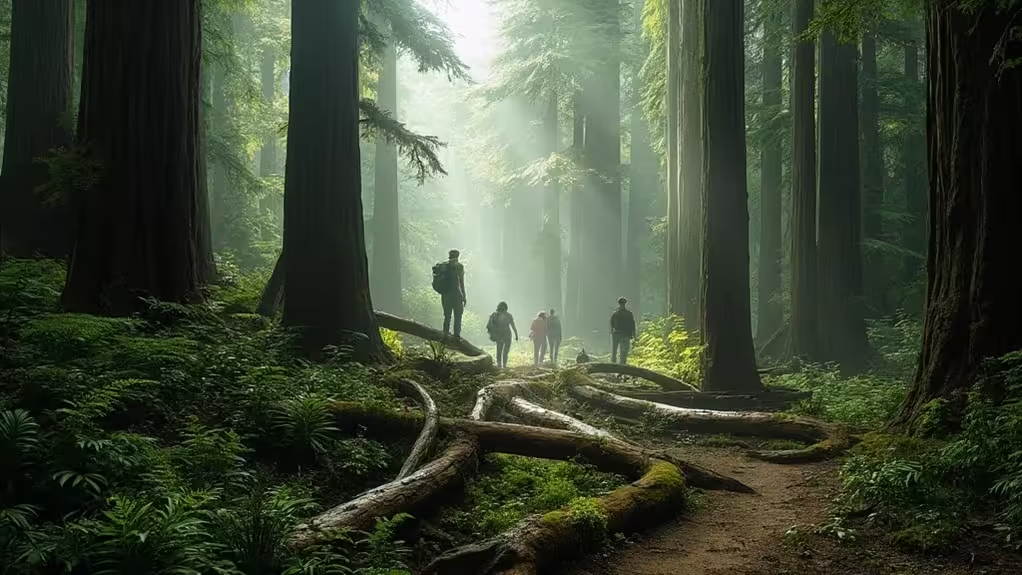
Nestled along California's northern coast, Redwood National Park offers visitors a chance to experience the awe-inspiring majesty of the world's tallest trees. You'll find yourself surrounded by ancient redwood forests, including the iconic Tall Trees Grove. The park's crown jewel is Hyperion, the tallest tree on Earth, standing at an impressive 379.1 feet.
To visit Hyperion, you'll need to plan ahead. Access is via Bald Hills Road, but you'll need a reservation for the locked gate leading to hiking trails. The hike to Hyperion is a 1.8-mile round trip with moderate difficulty, involving creek crossings and log climbing. For the best experience, plan your visit between July and October when creek levels are lower.
Here's what you can expect when visiting Redwood National Park:
- Breathtaking views of towering redwoods
- Challenging hikes through pristine forests
- Opportunities to spot diverse wildlife
- A chance to connect with nature's giants
As you investigate the park's numerous hiking trails, you'll feel a sense of freedom and wonder amidst these ancient giants. Remember to respect the park's rules and leave no trace, ensuring future generations can enjoy this natural wonder.
Cultural Significance of Tall Trees
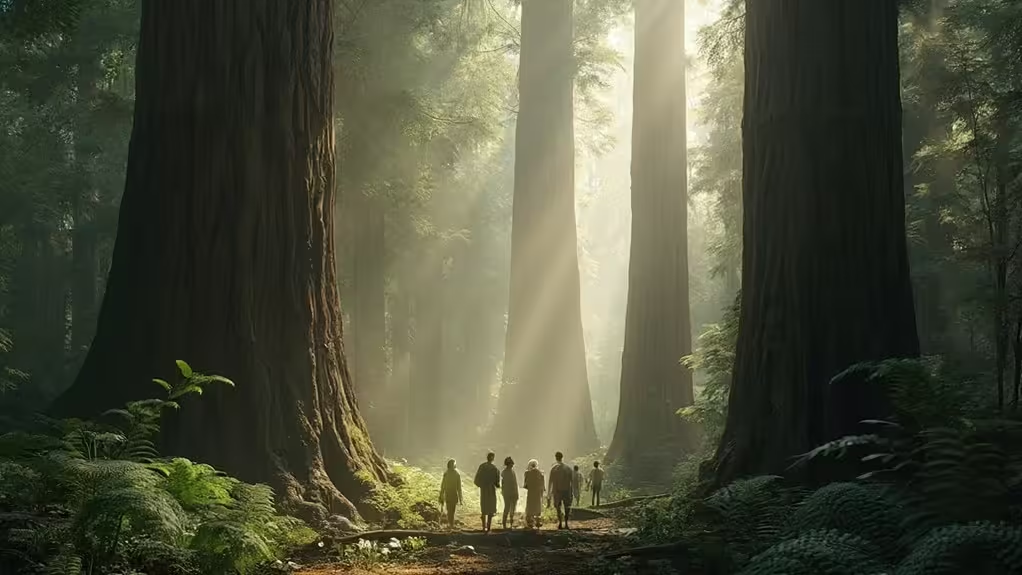
Towering giants like redwoods have enthralled human imagination for millennia, becoming deeply woven into the cultural fabric of various societies. These majestic trees, with their awe-inspiring heights and longevity, embody strength and resilience in countless cultures worldwide. You'll find that redwoods, in particular, hold a special place in people's hearts, inspiring conservation efforts and reverence for nature's wonders.
Indigenous cultures often view these tall trees as sacred, using them as sites for rituals and storytelling. They serve as powerful symbols, connecting the earthly domain to the heavens above. The Hyperion tree, standing at an impressive 379.1 feet, isn't just a natural marvel—it's a cultural icon that sparks wonder and admiration.
You'll uncover that trees like the ancient Cypress of Abarqu in Iran hold deep cultural significance, representing endurance and ties to age-old traditions. These living monuments have inspired myths and legends throughout history, often seen as Earth's protectors. By understanding the cultural importance of tall trees, you'll gain a deeper appreciation for their role in human society and the urgent need for their conservation.
Frequently Asked Questions
Where Are the Tallest Redwood Trees in the World?
You'll find the world's tallest redwoods in Northern California's secret havens. These giants of freedom, like Hyperion and Helios, tower over 370 feet in Redwood National Park. Don't miss Stratosphere Giant in Humboldt Redwoods State Park!
Is It Illegal to Visit Hyperion Tree?
Yes, it's illegal to visit Hyperion. You'll face hefty fines and possible jail time if caught. But don't let that stop your adventurous spirit! There are plenty of other incredible redwoods you can investigate legally and safely.
What Is the Second Tallest Redwood Tree in the World?
Hey, tree-hugging rebel! You're dying to know the second tallest redwood? It's Helios, standing proud at 377 feet. You won't find its exact location easily, but that's half the fun, isn't it? Happy hunting!
Where Is the Best Place to See the Biggest Redwoods?
You'll find the most awe-inspiring redwoods in Redwood National Park, California. Break free from the ordinary and investigate the Tall Trees Grove. Don't miss Humboldt Redwoods State Park for a chance to see the Stratosphere Giant.

